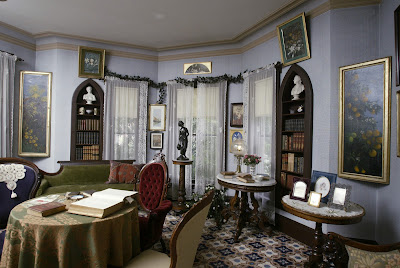View Harriet Beecher Stowe Center in a larger map
Visit our Tour Destination: Connecticut page to see the entire tour of the state’s Save America’s Treasures sites.
 |
| Harriet Beecher Stowe House, south front view. Photo courtesy of the Harriet Beecher Stowe Center. |
Website: Harriet Beecher Stowe Center
The Treasure: Harriet Beecher Stowe, the
celebrated author of Uncle Tom’s Cabin, lived in
this brick Victorian Gothic cottage-style house on Forest Street in Hartford,
Connecticut, from 1873 to her death in 1896.
Accessibility: The Harriet Beecher
Stowe Center
 |
| Uncle Tom's Cabin, M. A. Donohue edition. Photo courtesy of the Harriet Beecher Stowe Center. |
Background: Harriet
Beecher Stowe (1811-1896) is best known as the author of Uncle
Tom’s Cabin, one of the most powerful works of American anti-slavery
literature ever published. Her combined passion for writing and combating
injustice drove her to publish a total of more than thirty different books,
many of them dealing with the most controversial topics of her day. In her
works, she tackled topics such as slavery, religious reform and gender roles.
Her informal style of writing allowed her to reach a broad audience and
challenge her society—at a time when women had very limited opportunities for influencing
public discourse.
Harriet Elisabeth Beecher was born on June 14, 1811 in Litchfield , Connecticut Litchfield Female Academy
Stowe’s most famous work, Uncle Tom’s Cabin, follows the
adventures of a small family of enslaved African Americans desperately trying
to escape their bondage. The first serialized installment was published on June
5, 1851 in the anti-slavery newspaper The National Era. When issued in book form, the work was a literal runaway success, selling over
1.5 million copies in its first year. It became a potent tool in the effort to win
the hearts and minds of mainstream Americans for the abolitionist movement as the country headed toward Civil War.
The Hartford
house was occupied by Stowe, her husband Calvin Stowe, and their two oldest and unmarried daughters, the twins Eliza and Hattie (Harriet), from
1873 until her death. While Stowe’s most famous work was behind her while living in Hartford, she continued
to write and to enjoy great popularity. The Stowes made an effort to live up to
the ideals they preached. For 15 years following the Civil War, they maintained
a winter residence in Mandarin, Florida ,
where they supported a school to educate newly emancipated slaves.
 |
| The kitchen at the Harriet Beecher Stowe House. Photo by Michael McAndrews, courtesy of the Harriet Beecher Stowe Center. |
Notes from the Editor: June is a month of anniversaries for the
Very few writers can claim to have influenced the course of
history to the degree that Stowe’s work did. Her clear and articulate calls for
justice still resonate:
“I wrote what I did because as a woman, as a mother, I was
oppressed and broken-hearted with the sorrows and injustice I saw, because as a
Christian I felt the dishonor to Christianity—because as a lover of my county,
I trembled at the coming day of wrath.”
“It's a matter of taking the side of the weak against the
strong, something the best people have always done.”
“Never give up, for that is just the place and time that the
tide will turn.”
The Harriet
Beecher Stowe
Center
Other Recommended Sites: While neither
Stowe’s birthplace in Litchfield , Connecticut , nor the school she attended (Litchfield Academy Cincinnati , Ohio Cincinnati
house, Stowe House, is maintained by the Ohio Historical Society and is open to
the public.
 |
| Front parlor at the Harriet Beecher Stowe House. Photo by Michael McAndrews, courtesy of the Harriet Beecher Stowe Center. |
Guest author for this entry: Terry Price
Tour America's History Itinerary
Friday’s destination: Florence Griswold Museum
© 2012 Lee and Terry Price


No comments:
Post a Comment